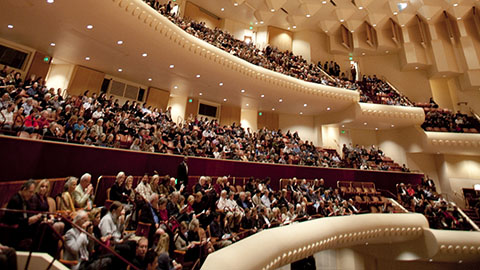Soothing, inspiring, motivating, saddening and often memory igniting; music is medicine for the soul just like air is essential to life.
The variety of genres are as spacious and mystical as the oceans.
Of all of the great cities in the world, San Francisco specializes in producing breath-taking music.
The San Francisco Symphony is one such prize.

grapplingstars.com femcompetitor.com article, symphony sfsymphony.org photo credit
The San Francisco Symphony, founded in 1911, is an orchestra based in the city.
Since 1980, the orchestra has performed at the Louise M. Davies Symphony Hall in the City's Hayes Valley neighborhood. The San Francisco Symphony Youth Orchestra (founded in 1981) and the San Francisco Symphony Chorus (1972) are part of the organization. Its current music director is Michael Tilson Thomas, who has held the position since September 1995.
Among various awards and honors for the orchestra are an Emmy Award and 15 Grammy Awards in the past 25 years.
“Music is probably the only real magic I have encountered in my life. There's not some trick involved with it. It's pure and it's real. It moves, it heals, it communicates and does all these incredible things.”… Tom Petty
What they have to express at sfsymphony.org is music to our ears. “The San Francisco Symphony sets the highest possible standard for excellence in musical performance at home and around the world; Enriches, serves, and shapes cultural life throughout the spectrum of Bay Area communities; Maintains financial stability and gains public recognition as a means of ensuring its ability to fulfill its mission.
The San Francisco Symphony provides the most extensive education and community programs offered by any American orchestra. It brings music into every classroom, K-12, in the San Francisco Unified School District, free of charge.
The Symphony’s Adventures in Music is the longest-running education program of its kind in the country. Begun in 1988, it teaches music to every child in grades one through five in San Francisco’s public schools, reaching more than 23,000 students. The Symphony’s Instrumental Training and Support program brings professional musicians into middle and high schools throughout the city to coach students once a week. It also provides technical assistance, supplies and concert tickets.
The acclaimed San Francisco Symphony Youth Orchestra, which has toured the world and made impressive recordings, gives pre-professional training to the Bay Area’s most gifted young musicians at no cost.”
That’s very impressive.
Understandably there are legions of admirers.
A Brief History of the San Francisco Symphony

grapplingstars.com femcompetitor.com article, symphony sfsymphony.org photo credit
By Paul Siegel
In 1906, the city of San Francisco, California, suffered one of the most devastating earthquakes ever to hit a major metropolitan area. Much of the city was destroyed by the temblor and resulting fires. A tight-knit community before the disaster, San Francisco's civic leaders were anxious to form a permanent orchestra to help close the cultural abyss created by the loss of life and property. The San Francisco Symphony (SFS) made its musical debut in December 1911, and it has remained a vital element of the city's cultural identity ever since.
Totaling only 60 musicians at its start, the SFS gave a total of eleven concerts in its first full season, although five of those concerts were comprised primarily of "popular" music. Alfred Hertz, who had led the Metropolitan Opera for several years, came west to take on the role of music director in 1915, and he was a major factor in convincing the Victor Talking Machine Company to record the orchestra in 1925, conveniently located across the bay at Victor's new studio in Oakland. The very first piece the orchestra recorded was the overture to the Auber opera, Fra Diavolo. Hertz also helped broaden the orchestra's appeal by having it perform live on radio; he retired in 1930.
The Great Depression caused significant financial distress for the San Francisco Symphony. Bankruptcy seemed likely after the orchestra cancelled its 1934-35 season, but voters in San Francisco approved a bond measure that provided significant public funding to cover operating expenses. French conductor Pierre Monteux, who enjoyed a wildly popular reputation from the podium during these years, was hired in 1935 to breathe new life into the SFS. He was so successful that the National Broadcasting Corp. (NBC) chose to broadcast many of the orchestra's concerts on its nationwide network, and the ensemble signed an exclusive recording agreement with RCA Victor in 1941. Several other European music directors followed Monteux after he left in 1952, including Spaniard Enrique Jordá and Austrian Joseph Krips. A young Seiji Ozawa made several guest conducting appearances with the San Francisco Symphony in 1970, and the public's immense appreciation for his exuberant style and novel programming -- he brought ballet to orchestra audiences plus semi-staged versions of rarely seen operas, such as Beatrice et Benedict by Hector Berlioz -- convinced him to stay on as Krips's successor. Ozawa also elected to become music director of the Boston Symphony. For several years he commuted regularly from East Coast to West in order to run both organizations.
Under the leadership of Dutch conductor Edo de Waart, who took over for Ozawa in 1977, the SFS concert season was greatly expanded. The city built Davies Symphony Hall in 1980, which meant the orchestra had both that venue as well as the War Memorial Opera House (where the orchestra had played exclusively since 1932) in which to perform. De Waart remained until 1985, when Swedish-American conductor Herbert Blomstedt replaced him. He began taking the orchestra on annual tours of Europe and Asia -- excursions the SFS had shunned until then -- and also helped redesign the acoustics of Davies Hall to make it more instrument-friendly.
Michael Tilson Thomas has led the San Francisco Symphony since 1995, coming to the organization directly from his stint with the London Symphony Orchestra. Thomas has been a strong advocate for music education, offering an expanded series of concerts for schoolchildren and also providing pre-concert talks that are popular with locals and tourists alike. Under his leadership the orchestra created its own recording label -- SFS Media -- and a series of CDs featuring Mahler symphonies have proven to be best sellers among classical music aficionados, as well as having won several Grammy Awards.
~ ~ ~
https://ezinearticles.com/?A-Brief-History-of-the-San-Francisco-Symphony&id=9067324
Article Source: https://EzineArticles.com/expert/Paul_Siegel/593261
Article Source: http://EzineArticles.com/9067324
https://www.brainyquote.com/quotes/topics/topic_music.html
https://www.sfsymphony.org/About-Us/Mission-History.aspx





















